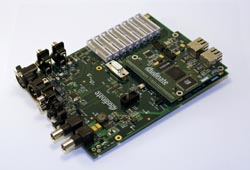Dante Demystified

Audinate's Dante evaluation and development kitThe newcomer in professional audio transports, Dante is the rumble from down under's Audinate. Quietly appearing on the scene at AES 2006, Dante has its roots from the Australian government technology incubator NICTA starting in 2003 and technologists from the telecom and zero configuration networking community as opposed to the audio industry.
Dante's ability to support varying (and very low) latencies, IP routability, automatic device-discovery, the use of text-based channel-and device-"friendly names", and its ability to make your favorite PC or Mac audio software application look like just another Dante-enabled device to the network via software drivers (no special hardware required, utilizing standard ethernet interface) has brought it much attention very quickly. The biggest challenge for Dante is not technical, but its "new kid" status.
Key Features
-Label-based routing
-Automatic Device Discovery and system configuration
-Routable over WANs
-Drivers for PC and MACs (no special hardware needed)
-Multiple sample rates and bit depths on same network?
The Lingo Zen
-Dante's automatic device discovery and system configuration protocol
-Dante-enabled devices auto detect each other
-IP addresses are automatically assigned
-Audio sources are referred to by "friendly names" using label-based routing
-Uses ZeroConf protocols (i.e. how iTunes finds other iTunes devices)
IP (Internet Protocol) Based
-IP based (layer 3, L3) not just ethernet-based (layer 2, L2)
-Routable through WAN and wireless
-Dante-enabled devices can
self-assign IP addresses if network doesn't have DHCP server
-Allows use of off-the-shelf networking components
Packet Types
-Multicast - Single source
-broadcast to many receivers
-Unicast - Single source to single receiver (point to point)
-Multi-Unicast - Multiple unicast transmissions?
A daily selection of the top stories for AV integrators, resellers and consultants. Sign up below.
